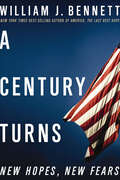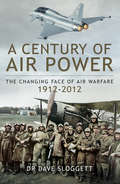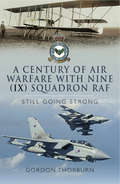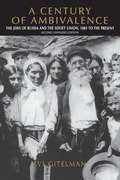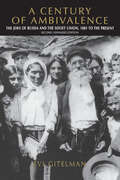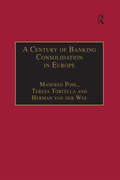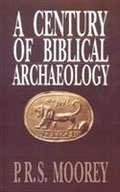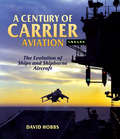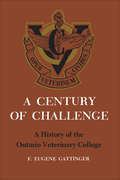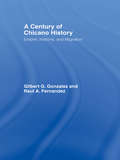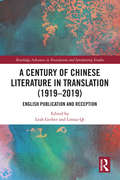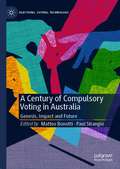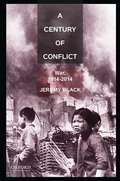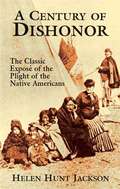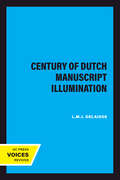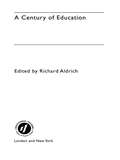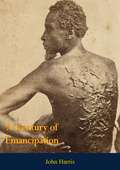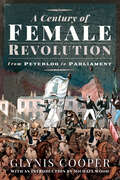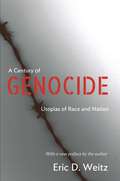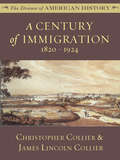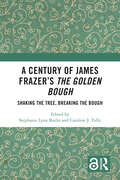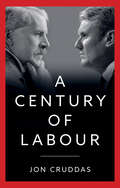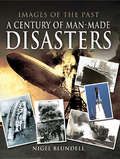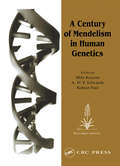- Table View
- List View
A Century Turns: New Hopes, New Fears
by William J. BennettA state of the union address as the twentieth century turned into the twenty-first—from the New York Times–bestselling author of America, the Last Best Hope.In A Century Turns, William J. Bennett explores America’s recent and momentous history—the contentious election of 1988, the fall of the Berlin Wall and the collapse of global Communism, the presidency of William Jefferson Clinton, the technological and commercial boom of the 1990s, the war on terror, and the election of America’s first black president.Surveying politics and pop culture, economics and technology, war and religion, Bennett pieces together the players, the personalities, the feats and the failures that transformed key moments in the American story. And he captures it all with piercing insight and unrelenting optimism.
A Century of Air Power: The Changing Face of Warfare, 1912–2012
by Dr. Dave SloggettAn extensive history of the first century of aerial warfare, covering the every major conflict including the two world wars. No other technical development since the introduction of gunpowder has had as great an influence on warfare as the aircraft. From its early beginnings as simply a means of aerial reconnaissance to its utter supremacy on the battlefield, the aircraft has evolved into the most versatile and precise killing machine known to man. In this wide-ranging and comprehensive study, David Sloggett, an internationally-respected defence analyst, investigates the changing role and increasing significance of air power over the course of the previous 100 years. This is accomplished by detailing every major conflict during that period including not only the two world wars and the recent conflicts in the Middle East but also the Korean War, the Cuban Missile Crisis, the Falklands War and Russian use of air power in Afghanistan. Air power&’s role in Malaya, Oman, Kenya and in Northern Ireland is also explained.A Century of Air Power is the most important study of the use of military aircraft ever undertaken and as such provides valuable lessons for the future—not only for the commanders who have to apply these all-powerful weapons but also for the politicians who have to determine its use.
A Century of Air Warfare With Nine (IX) Squadron, RAF: Still Going Strong
by Gordon ThorburnIn the earliest days of World War One, when IX Squadron was formed, we went to the fight in little 50mph machines that were barely capable of taking pilot and observer, a gun and a few small, hand-held bombs into the sky, especially on a windy day. When we took a wireless set, to spot for the artillery and report on troop movements, the extra load forced the defenceless pilot to leave his observer behind.A century later, IX (B) Squadron flies jets that can exceed the speed of sound, place laser-guided missiles within a few centimetres of the target, and transmit the most complex data in real time across the globe.In between, the tale is of ponderous beasts of biplanes, of Wellingtons and Lancasters in the bloody battles of World War Two, of Canberras and Vulcans in the nuclear age of the Cold War.Above all, it's the story of the men and women of the RAF's senior bomber squadron across a hundred years of war and peace, and their words fill this book. We go from those beginnings in wood, wire and fabric kites over France and a pilot armed with a service revolver, to the world's first Tornado squadron in the Gulf wars, over Kosovo and Afghanistan, and so to the present, a century on.It really is one hell of a story.
A Century of Ambivalence: The Jews of Russia and the Soviet Union, 1881 to the Present
by Zvi GitelmanA richly illustrated survey of the Jewish historical experience in the Russian Empire, the Soviet Union, and the post-Soviet era. "Anyone with even a passing interest in the history of Russian Jewry will want to own this splendid... book." -- Janet Hadda, Los Angeles Times. "... a badly needed historical perspective on Soviet Jewry.... [Gitelman] is evenhanded in his treatment of various periods and themes, as well as in his overall evaluation of the Soviet Jewish experience.... A Century of Ambivalence is illuminated by an extraordinary collection of photographs that vividly reflect the hopes, triumphs and agonies of Russian Jewish life." -- David E. Fishman, Hadassah Magazine. "Wonderful pictures of famous personalities, unknown villagers, small hamlets, markets and communal structures combine with the text to create an uplifting [book] for a broad and general audience." -- Alexander Orbach, Slavic Review. "Gitelman's text provides an important commentary and careful historic explanation.... His portrayal of the promise and disillusionment, hope and despair, intellectual restlessness succeeded by swift repression enlarges the reader's understanding of the dynamic forces behind some of the most important movements in contemporary Jewish life." -- Jane S. Gerber, Bergen Jewish News. "... a lucid and reasonably objective popular history that expertly threads its way through the dizzying reversals of the Russian Jewish experience." -- Village Voice. A century ago the Russian Empire contained the largest Jewish community in the world, numbering about five million people. Today, the Jewish population of the former Soviet Union has dwindled to half a million, but remains probably the world's third largest Jewish community. In the intervening century the Jews of that area have been at the center of some of the most dramatic events of modern history -- two world wars, revolutions, pogroms, political liberation, repression, and the collapse of the USSR. They have gone through tumultuous upward and downward economic and social mobility and experienced great enthusiasms and profound disappointments. In startling photographs from the archives of the YIVO Institute for Jewish Research and with a lively and lucid narrative, A Century of Ambivalence traces the historical experience of Jews in Russia from a period of creativity and repression in the second half of the 19th century through the paradoxes posed by the post-Soviet era. This redesigned edition, which includes two substantial new chapters on the fate of Jews and Judaism in the former Soviet Union, is ideal for general readers and classroom use. Zvi Gitelman is a Professor of Political Science and the Director of the Jean and Samuel Frankel Center for Judaic Studies at the University of Michigan. He is author of Jewish Nationality and Soviet Politics: The Jewish Sections of the CPSU, 1917--1930 and editor of Bitter Legacy: Confronting the Holocaust in the USSR (Indiana University Press).
A Century of Ambivalence: The Jews of Russia and the Soviet Union, 1881 to the Present
by Zvi Gitelman“Illuminated by an extraordinary collection of photographs that vividly reflect the hopes, triumphs and agonies of Russian Jewish life.” —David E. Fishman, Hadassah MagazineA century ago the Russian Empire contained the largest Jewish community in the world, numbering about five million people. Today, the Jewish population of the former Soviet Union has dwindled to half a million, but remains probably the world’s third largest Jewish community. In the intervening century the Jews of that area have been at the center of some of the most dramatic events of modern history—two world wars, revolutions, pogroms, political liberation, repression, and the collapse of the USSR. They have gone through tumultuous upward and downward economic and social mobility and experienced great enthusiasms and profound disappointments.In startling photographs from the archives of the YIVO Institute for Jewish Research and with a lively and lucid narrative, A Century of Ambivalence traces the historical experience of Jews in Russia from a period of creativity and repression in the second half of the 19th century through the paradoxes posed by the post-Soviet era. This redesigned edition, which includes more than 200 photographs and two substantial new chapters on the fate of Jews and Judaism in the former Soviet Union, is ideal for general readers and classroom use.Published in association with YIVO Institute for Jewish Research“Anyone with even a passing interest in the history of Russian Jewry will want to own this splendid . . . book.” —Los Angeles Times“A lucid and reasonably objective popular history that expertly threads its way through the dizzying reversals of the Russian Jewish experience.” —The Village Voice
A Century of Banking Consolidation in Europe: The History and Archives of Mergers and Acquisitions (Studies in Banking and Financial History)
by Manfred Pohl Teresa TortellaFrom the late nineteenth century to the late twentieth century the European banking sector experienced countless mergers and acquisitions. The outcome of this century of consolidation is strikingly similar across the continent, with the banking sector of each country now dominated by a handful of giant banking corporations. Consolidation and concentration trends in banking was the theme of the Academic Archive Colloquium of the European Association for Banking History held in Madrid in June 1997. This volume is comprised of the 18 papers and responses presented at the Colloquium by a truly international group of delegates. Some of the themes explored in the book include: the significance of mergers for bank archives; the regulation of mergers and their impact on banking legislation; reactions to consolidation from within and without the banking industry; case studies of particular mergers and their impact on the wider banking community. Youssef Cassis's introductory chapter provides a general survey of trends in the consolidation process and suggests that the advent of the Euro may herald a new era in the history of European banking consolidation.
A Century of Biblical Archaeology
by P. R. S. MooreyThis historical survey of the relationship between archaeology and biblical studies in the archaeological excavations in Palestine at Tell el-Hesi from 1840 to 1990 concentrates on the work of major excavators and scholars. It is a panoramic overview of the methods and theories that served to illuminate the archaeology of the Holy Land, beginning with an introductory chapter that covers the early pioneering years before the work of Pitt Rivers and Petrie.
A Century of Carrier Aviation: The Evolution of Ships and Shipborne Aircraft
by David HobbsIt is now almost exactly a hundred years since a heavier-than-air craft first took off and landed on a warship, and from the very beginning flying at sea made unique demands on men and machines. As warplanes grew larger, faster and heavier, air operations from ships were only possible at all through constant development in technology, techniques and tactics. This book charts the progress and growing effectiveness of naval air power, concentrating on the advances and inventions - most of them British - that allowed shipborne aircraft to match their land-based counterparts, and looking at their contribution to 20th century warfare. Written by a retired Fleet Air Arm pilot and and award-winning historian of naval flying, this is a masterly overview of the history of aviation in the world's navies down to the present day. Heavily illustrated from the author's comprehensive collection of photographs, the book will be essential reading to anyone with an interest in navies or air power.
A Century of Challenge: A History of the Ontario Veterinary College
by Friston Eugene GattingerIn lively fashion Mr. Gattinger records the development of the Ontario Veterinary College, the oldest continuously operating veterinary school in this hemisphere. Viewing its history from the perspective of today, he sees the College and the profession it serves moving in response to the times, from a discipline centred mainly on the study of equine diseases to a highly specialized field of endeavour contributing to the research and technological advances of the modern age. Under its five principals the College has in each era of its history been the training-ground of experts in an important aspect of the agricultural industry, and its adaptation to changing conditions and to the personalities of its successive leaders, in Mr. Gattinger's view, makes it a striking example of the theory put forward by Professor Toynbee of growth through challenge and response. In celebrating its hundredth anniversary the College thus pays tribute to its founders and to the several generations of teachers and research workers who have served it.
A Century of Chicano History: Empire, Nations and Migration
by Gilbert G. Gonzalez Raul E. FernandezThis study argues for a radically new interpretation of the origins and evolution of the ethnic Mexican community across the US. This book offers a definitive account of the interdependent histories of the US and Mexico as well as the making of the Chicano population in America. The authors link history to contemporary issues, emphasizing the overlooked significance of late 19th and 20th century US economic expansionism to Europe in the formation of the Mexican community.
A Century of Chinese Literature in Translation: English Publication and Reception (Routledge Advances in Translation and Interpreting Studies)
by Leah Gerber; Lintao QiThis book delves into the Chinese literary translation landscape over the last century, spanning critical historical periods such as the Cultural Revolution in the greater China region. Contributors from all around the world approach this theme from various angles, providing an overview of translation phenomena at key historical moments, identifying the trends of translation and publication, uncovering the translation history of important works, elucidating the relationship between translators and other agents, articulating the interaction between texts and readers and disclosing the nature of literary migration from Chinese into English. This volume aims at benefiting both academics of translation studies from a dominantly Anglophone culture and researchers in the greater China region. Chinese scholars of translation studies will not only be able to cite this as a reference book, but will be able to discover contrasts, confluence and communication between academics across the globe, which will stimulate, inspire and transform discussions in this field.
A Century of Compulsory Voting in Australia: Genesis, Impact and Future (Elections, Voting, Technology)
by Matteo Bonotti Paul StrangioCompulsory voting has operated in Australia for a century, and remains the best known and arguably the most successful example of the practice globally. By probing that experience from several disciplinary perspectives, this book offers a fresh, up-to-date insight into the development and distinctive functioning of compulsory voting in Australia. By juxtaposing the Australian experience with that of other representative democracies in Europe and North America, the volume also offers a much needed comparative dimension to compulsory voting in Australia. A unifying theme running through this study is the relationship between compulsory voting and democratic well-being. Can we learn anything from Australia’s experience of the practice that is instructive for the development of institutional bulwarks in an era when democratic politics is under pressure globally? Or is Australia’s case sui generis – best understood in the final analysis as an intriguing outlier?
A Century of Conflict: War, 1914-2014
by Jeremy Black<p>The centenary of the start of World War One in 1914 provides an opportunity to assess the role and impact of conflict in the history of the last century, and also to consider how warfare has changed. A Century of Conflict offers a clear, global study of these topics that is both conceptually and methodologically up to date. Renowned historian Jeremy Black gives special consideration to Asia, Africa, and Latin America, placing the more conventional cast of conflicts--namely the two World Wars and the Cold War--into wider geographical and social contexts. <p>Analyzing the multiple dimensions and spheres of war, Black contends that there is no one true type of warfare or one single pattern of development. Instead, he emphasizes the wide scope of conflict ranging from regular warfare between large, professional forces to loosely defined battles. While Black acknowledges that war is often a consequence or product of other developments--notably political, economic, or technological--he argues that war can also have autonomous characteristics. Amply illustrated with nineteen full-color maps, A Century of Conflict provides room for debate concerning the different ways that historians interpret military history.</p>
A Century of Dishonor: The Classic Exposé of the Plight of the Native Americans (Native American)
by Helen Hunt JacksonSharply critical of the United States government's cruelty toward Native Americans, this monumental study describes the maltreatment of Indians as far back as the American Revolution. Focusing on the Delaware and the Cheyenne, the text goes on to document and deplore the sufferings of the Sioux, Nez Percé, Ponca, Winnebago, and Cherokee — in the process revealing a succession of broken treaties, the government's forced removal of tribes from choice lands, and other examples of inhuman treatment of the nation's 300,000 Indians. Stirring and eloquently stated, A Century of Dishonor was written in the hope of righting the wrongs inflicted upon this nation's first inhabitants. Within a year following its publication (1881), the book helped create the powerful Indian Rights Association. Decades later, author and critic Allen Nevins described the volume as "one of the soundest and most exhaustive works" ever written about Indian rights. Still a valuable reference, this book will be welcomed by students, historians, and others interested in the plight of Native Americans.
A Century of Dutch Manuscript Illumination (California Studies in the History of Art #6)
by L.M.J. DelaisseThis title is part of UC Press's Voices Revived program, which commemorates University of California Press’s mission to seek out and cultivate the brightest minds and give them voice, reach, and impact. Drawing on a backlist dating to 1893, Voices Revived makes high-quality, peer-reviewed scholarship accessible once again using print-on-demand technology. This title was originally published in 1968.
A Century of Education (Education K-12 Ser. #14)
by Richard AldrichEducation is a country's biggest business and the most important shared experience of those who live in it. A Century of Education provides an accessible, authoritative and fascinating overview of the role and nature of education in the twentieth century. Eminent historian of education, Professor Richard Aldrich has assembled a team of contributors, all noted experts in their respective fields, to review the successes and failures of education in the last century and to look forward to the next. A succinct overview of twentieth century social, economic, political and intellectual developments in the first chapter is followed by chapters on ten key topics. Each chapter has four sections: a review of the educational situation in 2000; a similar assessment in 1900; changes and continuities throughout the century; and a conclusion reviewing the lessons for today and tomorrow. This is a work of information, interpretation and reference, which demonstrates the strengths and weaknesses of education during the twentieth century and identifies educational priorities for the twenty first. For anyone interested in what has become the most important Issue of our time, this unique book is set to become a classic text.
A Century of Emancipation
by John HarrisA Century of Emancipation, written by the English anti-slavery campaigner John Harris and first published in 1933, represents an invaluable compendium for the student of slavery and its allied forms of contract labor and forced labor, both in their historical setting and in their contemporary aspects. In this book, the author is concerned with all kind of slavery, including that of East Indians and Mongolians in the West Indies, of Kanakas in Polynesia, and of the motley crowd along the Putumayo River in South America.This book is not merely an attempt to portray suffering, it is also an attempt to give a brief account of the systems under which these things have been done, and still more an effort to recount the light and shade of the great struggles carried on by a mere handful of earnest souls beginning with Clarkson, Wilberforce, Buxton, Pitt, Sturge, Macaulay, Lushington. Grey, Livingstone, then on to Vandervelde, Dilke, Fox Bourne, Morel, Hodgkin and others.The book shows how those who have struggled and are still struggling with these sordid but powerful forces have never numbered more than a few hundreds. Whilst it may be true that those few hundreds have been men and women of wisdom and influence, yet it is even more true that they have been men and women possessed of souls burning with a spiritual passion for freedom and justice—that was and is their chief source of strength.
A Century of Female Revolution: From Peterloo to Parliament
by Glynis CooperThis dramatic social history follows the struggle for women’s rights in England from the Industrial Revolution to the Suffragist victory after WWI.The 100 years from 1819-1919 saw remarkable change for women in England. From the early nineteenth century, when women were not even considered ‘persons' under the law, they achieved full legal rights and status. The doors of education and employment were thrown open to them, and by 1919, they won universal suffrage.As workers organized in the North-West to demand better conditions in the textile industries, women formed their own groups to support the cause—and fight for their own rights. Blowback came in August of 1819, in the form of the Peterloo Massacre.The brutality of that day brought attention to the women’s cause and encouraged them to continue the fight. Women became involved in reform groups, Chartism, trade unions, politics, education, career opportunities and the right to vote. Though they faced hostility from both men and women, their perseverance paid off for generations of women to come.
A Century of Genocide: Utopias of Race and Nation - Updated Edition
by Eric D. WeitzWhy did the twentieth century witness unprecedented organized genocide? Can we learn why genocide is perpetrated by comparing different cases of genocide? Is the Holocaust unique, or does it share causes and features with other cases of state-sponsored mass murder? Can genocide be prevented?Blending gripping narrative with trenchant analysis, Eric Weitz investigates four of the twentieth century's major eruptions of genocide: the Soviet Union under Stalin, Nazi Germany, Cambodia under the Khmer Rouge, and the former Yugoslavia. Drawing on historical sources as well as trial records, memoirs, novels, and poems, Weitz explains the prevalence of genocide in the twentieth century--and shows how and why it became so systematic and deadly.Weitz depicts the searing brutality of each genocide and traces its origins back to those most powerful categories of the modern world: race and nation. He demonstrates how, in each of the cases, a strong state pursuing utopia promoted a particular mix of extreme national and racial ideologies. In moments of intense crisis, these states targeted certain national and racial groups, believing that only the annihilation of these "enemies" would enable the dominant group to flourish. And in each instance, large segments of the population were enticed to join in the often ritualistic actions that destroyed their neighbors.This book offers some of the most absorbing accounts ever written of the population purges forever associated with the names Stalin, Hitler, Pol Pot, and Milosevic. A controversial and richly textured comparison of these four modern cases, it identifies the social and political forces that produce genocide.
A Century of Immigration: 1820 - 1924
by James Lincoln Collier Christopher CollierHistory is dramatic -- and the renowned, award-winning authors Christopher Collier and James Lincoln Collier demonstrate this in a compelling series aimed at young readers. Covering American history from the founding of Jamestown through present day, these volumes explore far beyond the dates and events of a historical chronicle to present a moving illumination of the ideas, opinions, attitudes and tribulations that led to the birth of this great nation. A Century of Immigration reviews the century of 1820 through 1920, in which there were two waves of immigration to the United States. This book discusses the varied motivations and nationalities of these new Americans, as well as the effects of mass immigration on the country as a whole, and the rise of antiforeign sentiments among more recent immigrants. The text is enhanced with photographs, and images of historic art & artifacts.
A Century of James Frazer’s The Golden Bough: Shaking the Tree, Breaking the Bough
by Stephanie Lynn Budin and Caroline J. TullyThis multidisciplinary volume examines the ongoing effects of James G. Frazer’s The Golden Bough in modern Humanities and its wide-ranging influence across studies of ancient religions, literature, historiography, and reception studies.The book begins by exploring the life and times of Frazer himself and the writing of The Golden Bough in its cultural milieu. It then goes on to cover a wide range of topics, including: ancient Near Eastern religion and culture; Minoan religion and in particular the origins of notions of Minoan matriarchy; Frazer’s influence on the study of Graeco-Roman religion and magic; Frazer’s influence on modern Pagan religions; and the effects of Frazer’s works in modern culture and scholarship generally. Chapters examine how modern academia and beyond continues to be influenced by the otherwise discredited theories in The Golden Bough, ideas such as Sacred Marriage and the incessant Fertility of Everything. The book demonstrates how scholarship within the Humanities as well as practitioners of alternative religions and the common public remain under the thrall of Frazer over one hundred years since the publication of the abridged edition of The Golden Bough, and what we must do to shake off that influence. A Century of James Frazer’s The Golden Bough is of interest to scholars and students from a wide range of disciplines, including Ancient History, History of Religion, Comparative Religion, Classical Studies, Archaeology, Historiography, Anthropology, Folklore, and Reception Studies.Chapter 18 of this book is freely available as a downloadable Open Access PDF at http://www.taylorfrancis.com under a Creative Commons Attribution (CC-BY) 4.0 license.
A Century of Labour
by Jon CruddasBritain’s first Labour government took office on 22 January 1924. Its centenary provides an opportunity to reassess the party's performance over the last 100 years, and with an election pending, the character and purpose of the modern party. Labour defined the dominant political settlement of much of the Twentieth Century: the welfare state. It has achieved much in pursuit of material change, social reform and equality. It has challenged patriarchy, racism and the legacy of imperialism, promoted human rights and delivered democratic and constitutional renewal. Yet any honest assessment must acknowledge a century littered with failures and missed opportunities. In this compelling book, Jon Cruddas, one of the country's foremost experts on Labour politics, details the vivid personalities and epic factional battles, the immense achievements and profound disappointments that define a century of Labour. Uniquely framed around competing visions of socialist justice within the Party, he provides a way to rethink Labour history, the divisions and factions on the left and to reassess key figures at the helm of the movement from Keir Hardie through to Keir Starmer.
A Century of Man-Made Disasters: A Century Of Man-made Disasters (Images of the Past)
by Nigel BlundellA pictorial history of the major man-made calamities that shocked the world throughout the twentieth century. It was a period during which the power and scale of industrialization changed the planet—an unforeseen consequence being the creation of more human-created catastrophes than ever before experienced. The events recorded here include the needless carnage of history&’s worst air disaster when two jumbo jets collided on the island of Tenerife. We recall the horrors of Aberfan, the Welsh village in which schoolchildren were buried alive. The story of the explosion aboard the Challenger space shuttle reveals how warnings that were ignored led to the deaths of seven astronauts. And we report on the failings that caused the nuclear nightmare at Chernobyl, a poisonous blot on the face of the globe. These and the other tragedies in this book were all man-made and, it seems, just waiting to happen. A further link between these horrific events is that they were all caused by either folly or greed—or both. But despite the tales of monstrous misfortune, many also produced heart-lifting stories of heroism, selflessness, sacrifice, and human resilience.
A Century of Man-Made Disasters: A Century Of Man-made Disasters (Images of the Past)
by Nigel BlundellA pictorial history of the major man-made calamities that shocked the world throughout the twentieth century. It was a period during which the power and scale of industrialization changed the planet—an unforeseen consequence being the creation of more human-created catastrophes than ever before experienced. The events recorded here include the needless carnage of history&’s worst air disaster when two jumbo jets collided on the island of Tenerife. We recall the horrors of Aberfan, the Welsh village in which schoolchildren were buried alive. The story of the explosion aboard the Challenger space shuttle reveals how warnings that were ignored led to the deaths of seven astronauts. And we report on the failings that caused the nuclear nightmare at Chernobyl, a poisonous blot on the face of the globe. These and the other tragedies in this book were all man-made and, it seems, just waiting to happen. A further link between these horrific events is that they were all caused by either folly or greed—or both. But despite the tales of monstrous misfortune, many also produced heart-lifting stories of heroism, selflessness, sacrifice, and human resilience.
A Century of Mendelism in Human Genetics
by Milo Keynes A.W.F. Edwards Robert PeelIn 1901 William Bateson, Professor of Biology at Cambridge, published a renewed version of a lecture which he had delivered the year before to the Royal Horticultural Society in London (reprinted in the book as an appendix). In this lecture he recognized the importance of the work completed by Gregor Mendel in 1865, and brought it to the notice of
